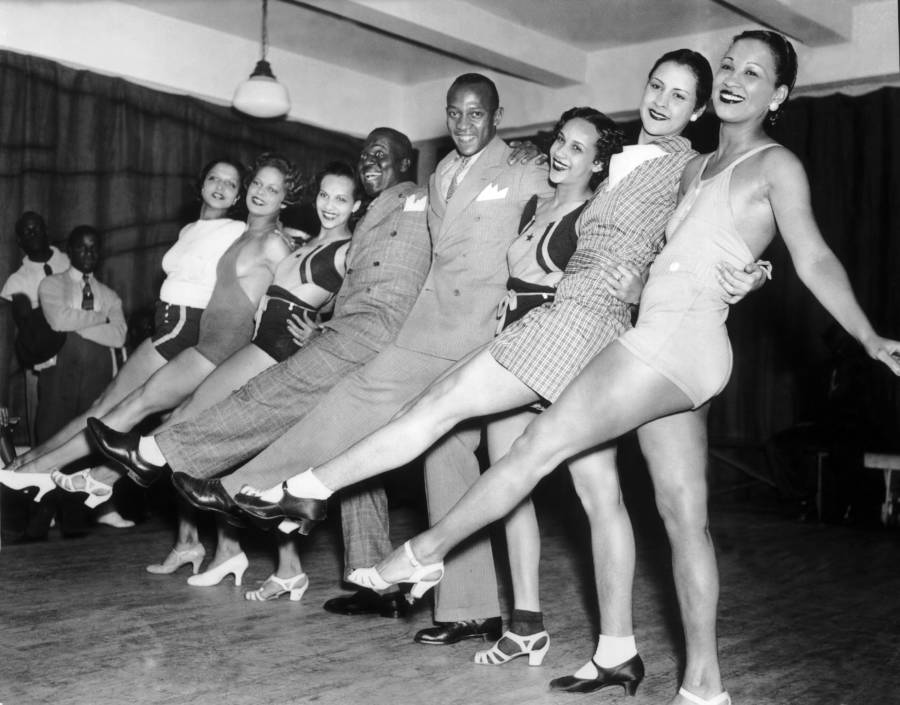African-American heavyweight boxer Jack Johnson purchased a fledgling casino at 142nd Street and Lenox Avenue in Harlem in 1920 as a supper club under the name Club Deluxe. He soon found being a successful boxer was one thing to being a stellar operator of an entertainment outlet.
When bootlegger and gangster Owney Madden - a white – acquired the property from the boxer in 1923, he renamed it the Cotton Club.
The Club then operated under a segregationist policy, engaging blacks to entertain white clients while barring blacks from paying to enjoy the show. Even the performers had to move to any of the black operated entertainment spots to relax, take in liquor and enjoy some marijuana.
Madden spent lots of cash renovating his new business venture, which he used as a vehicle to sell his “No. 1” beer during the American Prohibition-era. He kept Johnson on as manager though and then redecorated the club in a mix of Southern plantation and jungle-type decor.
The Club being a whites-only establishment had the strictest segregation policy of all the Harlem cabaret clubs at the time. The club’s draw consisted of musical revues, singing, dancing, comedy, variety acts, as well as the famed house band.
Fletcher Henderson was the first bandleader, with Duke Ellington who recorded over 100 compositions taking the helm in 1927. Ellington made his Cotton Club debut on December 4, 1927, in a revue produced by Dan Healy and comprising some 15 acts with a number of encores. The big numbers which included “Dancemania” and “Jazzmania” featured Cotton Club singers and a chorus of women dancers who would be billed as the Cotton Club Girls.
Others who made their name at the club included Dorothy Dandridge, Lena Horne, Cab Calloway, Adelaide Hall, Bill “Bojangles” Robinson, Ethel Waters, and Louis Armstrong. In 1934, Adelaide Hall starred in the “Cotton Club Parade,” the highest-grossing show the club ever had. It ran for eight months, brought in 600,000 customers.
To become a dancer at the Cotton Club, hopefuls needed to be 5’6″ or taller, light-skinned African-American and under 21 years old.
The Cotton Club Girls were famous for shimmying in long-feathered gowns and high-heeled shoes, strutting and snapping to the pervasive, insistent rhythms of hot jazz with cool sophistication.
Tap dance choreographer Henry LeTang cited one of the early choreographers of the Cotton Club as being Elida Webb. When Florence Mills went to England in 1926 with Blackbirds, two of her fellow performers were Hyacinth Curtis and Clarence Robinson.
The Cotton Club Girls in the early years included Mae Robinson and Isabel Washington, as well as sisters Hilda and Vivian Brown, Margaret Cheraux, Millicent Cook, Mildred Dixon, Peggy Griffiths, Carolyn Rich Henderson, Ethel, Lucia and Julia Moses, Julia Noisette, Evelyn Shepard and Tondelayo.
On the back of the success of the Cotton Club Girls, The Cotton Club Boys, a chorus of male African-American dancers who appeared exclusively in Cotton Club performances made their debut in the Spring of 1934 Edition of the Cotton Club Parade.

Dozens were auditioned and ten were finally chosen: Maxie Armstrong, Louis Brown, Charles “Chink” Collins, Howard “Stretch” Johnson, Thomas “‘Chink” Lee, Eddie Morton, Tommy Porter, Walter Shepherd, William Smith, and Jimmy Wright. They were made a feature act of the show and their new style of group dancing, in which all moved together in rhythmic unison, was immediately popular. At the end of an eight-month run they became an established feature at the Club. The Boys later performed in specialty acts at the Apollo Theater and also toured with Cab Callaway and his band.
Black writer and poet Langston Hughes observed “Harlem Negroes did not like the Cotton Club … nor did ordinary Negroes like the growing influx of whites toward Harlem after sundown, flooding the little cabarets and bars where formerly only colored people laughed and sang, and where now the strangers were given the best ringside tables to sit and stare at the Negro customers — like amusing animals in a zoo.”

Other Harlem nightclubs like the Savoy Ballroom, Lenox Club and the Renaissance Ballroom were where blacks held their jams and even for Cotton Club black performers author Steve Watson notes that they “visited the basement of the superintendent at 646 Lenox, where they imbibed corn whiskey, peach brandy, and marijuana.”
The original Cotton Club was at the height of its popularity from 1922 to 1935 but with the outbreak of the Harlem riots in 1935, the club never truly recovered. It relocated to another New York location and never regained its earlier magic. It closed in 1940.










